Today's Best Fishing Times
Get the best fishing times for Hall Lake with Lake-Link's Fishing Forecast. SEE MORE


Share Your Catch & Win!
Frequently Asked Questions About Hall Lake, MN
- How big is Hall Lake?
- How deep is Hall Lake?
- What kind of fish can you catch in Hall Lake?
- What are the closest cities to Hall Lake?
- Are there places to stay in the Hall Lake area?
- Are there topographical lake maps available Hall Lake?
- Are there boat launches on Hall Lake?
- Are there places to eat and drink near Hall Lake?
- What is the average air temp for Hall Lake?
How big is Hall Lake?
How deep is Hall Lake?
What kind of fish can you catch in Hall Lake?
Other fish species in the lake include Fathead Minnow, Freshwater Drum, Golden Shiner, Green Sunfish, Johnny Darter, Orangespotted Sunfish, Quillback, Shorthead Redhorse, Spotfin Shiner and White Sucker.
What are the closest cities to Hall Lake?
Are there places to stay in the Hall Lake area?
More Lodging Options
Are there topographical lake maps available Hall Lake?
Are there boat launches on Hall Lake?
Are there places to eat and drink near Hall Lake?
Explore the Hall Lake area in a RV
Are you looking for an adventurous vacation option that won't break the bank? Look no further than renting an RV! Contrary to popular belief, the process is much simpler than you might imagine. With just a few easy steps, you'll soon be experiencing the ultimate freedom and convenience of exploring the open road in your very own recreational vehicle. And the best part? RV travel can save you up to 60% compared to other types of vacations! With the money you'll save, you'll be able to travel even more and create unforgettable memories along the way. So why wait? Start planning your next adventure today with an RV rental. Learn more about renting a RV.



2020 Lightning Aluminum Enclosed 5-place Snowmobile Trailer
Lakeville, MN

History & Status of the Fishery
Hall Lake is a 513 acre lake of which 277 acres are within the littoral zone of 15 feet or less. The lake has been dredged and has a maximum depth of 27.0 feet. Hall Lake is part of the "Fairmont Chain of Lakes" and is within the city limits of Fairmont. The Fairmont Chain of Lakes (from headwaters to mouth) is comprised of Amber Lake, Hall Lake, Budd Lake, Sisseton Lake, and George Lake which are all natural impoundments of Center Creek in the Blue Earth River Watershed. Hall Lake is the largest and deepest of the lakes with a watershed-to-lake ratio of 43 indicating a large influence of the watershed effects in the lake. The city of Fairmont operates a storm water runoff system that empties into the lakes and the city also draws drinking water from Budd Lake, so it is imperative to reduce negative influences of water impairments in the watershed to improve the water quality in the lakes. Martin County Soil and Water Conservation District has taken the lead on this and has implemented some projects that help reduce the effects of water quality impairments on the lake, but more can be done to virtually eliminate all influences through best management practices in the watershed. Fish community changes over time tell us a lot about the health of an aquatic environment and its water quality. Hall Lake is a class 43 lake and is managed primarily for walleye while crappie, yellow perch and channel catfish are managed secondarily. Fish population assessments have been conducted every 4 to 6 years since 1984 with an initial assessment conducted in 1953. A recent fish population assessment was conducted during the week of August 22, 2011 to analyze the current management of species in Hall Lake and to determine changes in the fish community over time.
In 2011, the walleye catch rates were 2.7 fish per gill net and 0.8 fish per trap net. The catch rates were within the normal range for gill nets (1.2 to 6.3 fish per net) and trap nets (0.3 to 1.2) but below the long-term average of 7.1 and the management goal of maintaining a gill net catch rate of 5.0 fish per net. While the catch rate did not meet the management goal, there is some sign of improvement since the 2005 survey. The gill net catch rate in 2005 was 1.0 fish per net indicating an increase in abundance of walleye in Hall Lake in 2011. Surplus walleye fingerling stocking (not part of the ordinary stocking plan) took place in the fall of 2011 (all Fairmont lakes included) which should continue to boost the population in Hall Lake. While the abundance was less than desired, the sizes of walleye in the population was good. The average length of fish in the gill nets was 14.9 inches and 12.4 inches in the trap nets with a range of 8.9 to 28.4 inches. Growth was average as walleye reached 13.9 inches by age 3. The average condition of the fish was fair. Usually, when condition is fair in August it indicates a population that is experiencing some kind of stress. In August the walleye should be feeding well and be past the reproductive stresses of spring indicating the stress is forage related. Competition for food with other species can be a huge factor in walleye success and there are many species to compete with in Hall Lake, most notable would be crappie and channel catfish (both on the rise in terms of abundance). Increasing the abundance of a top predator such as northern pike (through a protected slot limit) may lead to decreased abundance of other species and lead to improvement in the overall walleye population as a result.
Yellow perch may be a good targeted species in Hall Lake. The 2011 gill net catch rate of yellow perch in Hall Lake was the second greatest in the history of population assessment sampling with a catch rate of 45.0 fish per gill net and greater than the long-term catch rate of 27.7 fish per net. The yellow perch catch rates indicate a population that is meeting management expectations. The size structure of the yellow perch was excellent; the average length of yellow perch caught in the gill nets and trap nets was 8.6 and 8.5 inches, respectively, with a range in length from 5.6 to 10.7 inches. The overall condition of the yellow perch in the sample was average, in August, which means the fish were exhibiting a less than desired overall condition in the peak of their prime growing season. The cause of the average condition factor may be explained by the high abundance of yellow perch in the sample causing a general decline in weight per individual due to competition for food resources. Overall, the yellow perch population is exceeding management goals for Hall Lake and will continue to maintain similar abundance for several years as the 8.5 inch average size fish continue to grow for 3 or 4 more years.
Bluegill are another managed species in Hall Lake. The management goal is to maintain the bluegill population within the normal trap net range of 7.5 to 62.5 fish per net for Hall Lake. The 2011 trap net catch rate was 4.9 fish per net which is below the normal range, falling short of the management goal, but near the long-term average catch rate of 6.1 fish per net. The size structure of the bluegill population favored larger fish; the average size of bluegill in the trap net sample was 7.5 inches with a range of 5.9 to 9.0 inches. The overall condition of the bluegill was good for an August sample. Overall, it appears the size structure and condition of bluegill in Hall Lake is good while the population level is at a less than preferred level. Even at low abundance the bluegill are doing well; given a successful spring spawn their abundance may increase.
In 2011, the channel catfish gill net catch rate was at the greatest level observed since sampling began in 1984 with a catch of 15.7 fish per gill net. The long-term average in Hall Lake is 5.0 fish per gill net, so the 2011 catch is over 3 times the long-term average. The catch rate of channel catfish in the trap nets was 4.2 fish per net, trap nets are not a target gear for channel catfish. The size structure of channel catfish in Hall Lake is very good; the average size of channel catfish caught in the gill nets was 18.2 inches with a range of 8.1 to 26.8 inches, fish up to 28.4 inches were caught in trap nets. The average condition of channel catfish was average, which is usual for an August sample and indicates a population that is finding adequate forage. Channel catfish would be an excellent targeted species in Hall Lake during those hot summer nights.
Two species of crappie are found in Hall Lake, black crappie and white crappie. Crappies are not managed species in Hall Lake, but they make up a significant portion of the fish community and they are native residents of the Fairmont Chain of Lakes. The black crappie catch rates in 2011 were 9.0 fish per gill net and 5.4 fish per trap net which were both within the normal ranges for gill nets (2.5 to 16.5 fish per net) and trap nets (1.8 to 21.2 fish per net). The black crappie catch rate was greater than the historical average of 2.2 per gill net and equal to the trap net long-term average of 5.4 fish per net. The white crappie catch rate was also greater than the historical average of 9.5 per gill net but less than the trap net long-term average of 10.9 fish per net (normal ranges; gill net [0.7 to 10.4 fish per net], trap net [0.5 to 6.6 fish per net]). The length of crappie were average as evidenced from their average length and range of lengths. The average length of black crappie in the sample was 7.0 inches in the gill nets and 7.9 inches in the trap nets with a range from 4.3 to 10.8 inches. The average length of white crappie in the sample was 7.5 inches in the gill nets and 7.9 inches in the trap nets with a range from 6.4 to 12.2 inches. The overall condition for black and white crappie was good indicating a population that is foraging successfully. The crappie populations in Hall Lake appear to be doing well, they are in high abundance, have an average size structure with some larger individuals, and are foraging successfully.
The Fairmont Chain of Lakes are some of the most diverse lakes for numbers of fish species in the Windom Fisheries Management Area. Twelve species of fish were caught in 2011 including the 6 listed above. The other species found in the sample were bullhead (black [0.7 per gill net, 0.1 per trap net] and yellow [1.0 per gill net, 0.3 per trap net]), common carp (3.0 per gill net, 3.4 per trap net), freshwater drum (46.3 per gill net, 3.3 per trap net), northern pike (0.7 per gill net, 0.2 per trap net) and white sucker (n=10; 2.0 per gill net, 0.4 per trap net).
Prepared by
Nate Hodgins
What is the average air temp for Hall Lake?
More Nearby Lakes To Explore
There's more lake's to explore around Hall Lake...| DISTANCE | ACRES | MAX DEPTH | |
| Amber Lake | 1.1 mi | 182 | 19 ft |
| Budd Lake | 1.2 mi | 228 | 23 ft |
| Sisseton Lake | 2.0 mi | 138 | 19 ft |
| George Lake | 2.7 mi | 83 | 11 ft |
| Willmert Lake (Main Bay) | 4.3 mi | 335 | 8 ft |
| Lake Imogene | 5.3 mi | 186 | 6 ft |
| Bright Lake | 7.0 mi | 639 | 7 ft |
| South Silver Lake | 7.1 mi | 252 | 22 ft |
| East Chain Lake | 7.6 mi | 481 | 6 ft |
| Iowa Lake | 8.1 mi | 705 | 9.4 ft |


















